Bisblock™: Desensitizing Effectively
Tooth sensitivity has always been a major concern in dentistry. Fluid movement inside the dentinal tubules can stimulate sensory nerves in dentin or pulp tissues.1 This phenomenon can be caused by exposure of the dentin structure, or by inaccurate sealing during bonding procedures.
To prevent and eliminate tooth sensitivity, Bisco (Schaumburg, Illinois) has introduced BisBlock™, an oxalate gel that will stimulate the precipitation of calcium oxalate crystals inside dentinal tubules, which will seal and eliminate fluid mobility, and thus, tooth sensitivity. The patented* technique of etching before the placement of BisBlock allows oxalate crystals to precipitate deep in the dentinal tubules, which will prevent the displacement of the dentinal fluids (Figure 1). After BisBlock has induced crystal precipitation, a non-acidic adhesive, such as One-Step® or One-Step® Plus (Bisco), should be applied. The adhesive will penetrate the dentinal tubules and through the calcium oxalate crystals. Once polymerized, a block or plug will be generated, sealing the dentin structure (Figures 2 and 3).
Crystal precipitation will occur in both enamel and dentin. However, calcium oxalate crystals in the enamel can interfere with proper bonding onto the enamel surface. This is why BisBlock is presented as a viscous yellow gel that allows the clinician to accurately place it only on dentin. If BisBlock is placed on enamel, the crystals should be removed by re-treating the enamel surface through acid-etching procedures.
The “total etch” technique of etching with phosphoric acid and the application of a dental adhesive has proven to be the most successful and lasting bonding procedure available to the dentist. However, this technique is very sensitive because of the need for moist surfaces for the proper placement of the adhesive after etching. Achieving “proper moisture” can be a difficult task, and if not done properly, it can lead to postoperative sensitivity. BisBlock will eliminate this sensitivity, allowing the clinician to perform the bonding procedure without the concern of patient discomfort.
References
1. Brännström M, Gaberoglio R. The dentinal tubules and the odontoblast processes. A scanning electron microscopic study. Acta Odontol Scand. 1972;30(3):291-311.This article was written by Rolando Nuñez, DDS, MS.
For More Information
Bisco Dental Products
Phone: 1-800-247-3368
Web: www.bisco.com
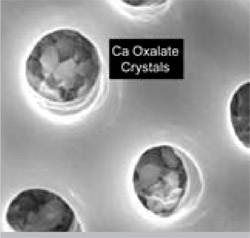 | 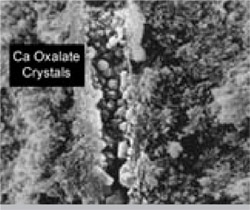 | |
| Figure 1 SEM top view. | Figure 2 SEM side view. | |
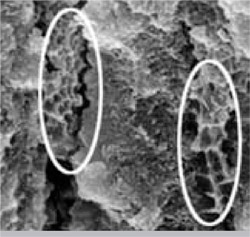 | ||
| Figure 3 SEM side view. |
SIDEBAR 1
CLINICAL PROCEDURE FOR DESENSITIZING EXPOSED ROOT SURFACES USING BISBLOCK:
- Etch exposed root surface with 32% phosphoric acid (UNI-ETCH®, BISCO) for 15 seconds (Figure 4).
- Rinse thoroughly with water (Figure 5).
- Gently air dry 2-3 seconds so there is no visible water on the surface (Figure 6).
- Apply BisBlock and allow to dwell for 30 seconds (Figure 7).
- Rinse thoroughly with water, leaving the surface slightly, but visibly,moist for wet bonding (Figure 8).
- Apply 2 generous coats (minimum) of ONE-STEP (OS) or ONE-STEP PLUS (OS+) adhesive (Figure 9).
- Evaporate the solvent using a gentle stream of air. The surface should be shiny. If it is not shiny, apply more OS or OS+ and evaporate solvent (Figure 10).
- Light-cure for a minimum of 10 seconds (Figure 11).
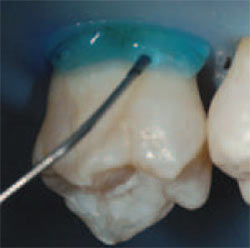 | 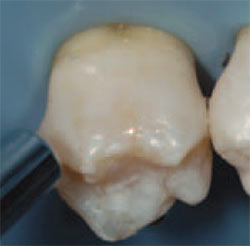 | |
| Figure 4 | Figure 5 | |
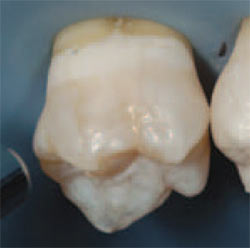 | 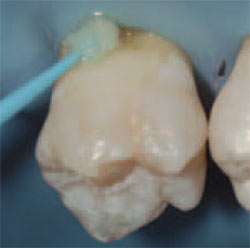 | |
| Figure 6 | Figure 7 | |
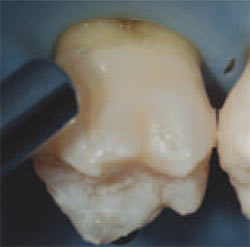 | 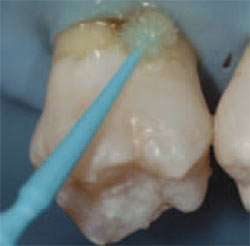 | |
| Figure 8 | Figure 9 | |
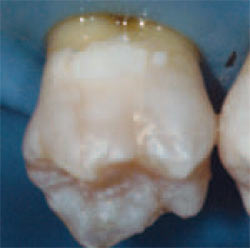 | 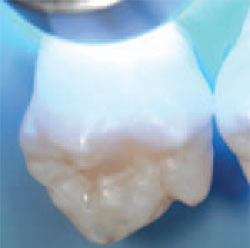 | |
| Figure 10 | Figure 11 |



